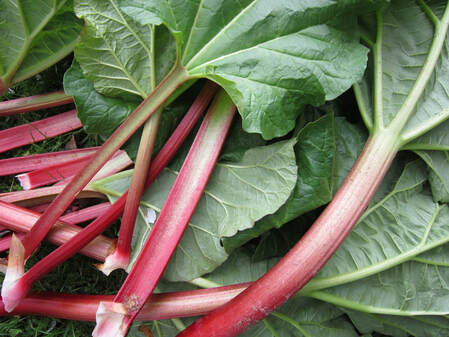rhubarbRhubarb has finally made its way back into my kitchen, and I am super pumped to share with you how I use rhubarb. Yes, it's often used in sweet preparations, but I'm here to share other fun ways to enjoy it in savory dishes. Before I delve into the recipes, let's begin with rhubarb basics: Rhubarb is a member of the knotweed family, which includes sorrel and buckwheat. Years before you or I were on this planet, rhubarb was found in China, Russia, Mongolia, and other parts of Central Asia. Traded originally as a luxury good, many sought out for its use as a detoxifying agent and curative herb. Choose firm, red stalks over green ones. The green lends itself to sour notes. When preparing rhubarb, first remove the large green leaves. They are extremely high in oxalic acid, which is poisonous and toxic to humans and some bugs when eaten in large amounts. The leaves can be used in insecticides, so if you have critters to fend off in the garden, explore its use as a DIY insecticide. Store in a bag wrapped in a towel inside the refrigerator for up to 1 week to prevent them drying out. Not going to use them within the week? Freeze it! Instead of storing in the refrigerator, simply cut the cleaned rhubarb into small, even pieces. Put in a freezer bag and close. Make sure all air is emptied and freeze for up to one year. In the kitchen, rhubarb requires balance dues its strong tartness, which is typically with sugar. Apart from the obvious uses like pie, bars, jams, and other desserts, try them pickled, in a porridge or stir-fry, as a compote, braised, or as a savory sauce over meat or fish! Tartness can vary from stalk to stalk. If possible, start with less sugar and gradually add more along the way. rhubarb nutritionAccording to the USDA National Data Base, 1 cup roughly provides: 25 kcal, 1g protein, 5.5 g CHO (2 g fiber), and is high in (5%) calcium, (5%) potassium, (8%) vit C, magnesium, and phosphorous, (22%) vitamin K. the recipesRamp & Rhubarb Chutney Makes roughly 1 ½ cups: serve with grilled cheese, use as a side on a cheese plate, or serve along spicy Indian food with naan. Ingredients: 1 Stalk of rhubarb, chopped 6 to 7 stalks of ramps, chopped 3 tablespoons brown sugar 3 to 4 tablespoons granulated sugar 1 teaspoon coriander 1 teaspoon cumin powder ¼ teaspoon salt 1 teaspoon Fresh Black Pepper ⅓ cup White Wine 1 teaspoon White Distilled Vinegar Directions
Rhubarb Relish Serve alongside split pea croquettes (or any vegetable croquette for that matter) or grilled meat/fish. Prep time: 20 minutes Cook time: 1 ½ hours (includes chilling time) Yield: approximately 8 cups Ingredients: 8 cups chopped rhubarb 8 cups onions, thinly sliced 7 cups granulated sugar 3 cups cider vinegar 2 tsp salt 2 tsp ground cloves 2 tsp ground cinnamon Directions: 1. Chop rhubarb into rough dice; set aside. 2. Add onions to separate bowl. Cover with boiling water; let sit for 5 minutes. Drain and discard water. 3. In heavy-bottomed pot, dissolve sugar in cider vinegar on medium heat. Add onions, rhubarb, salt, cloves and cinnamon. Stir well. Cook, stirring often, until it reaches a thick jam-like consistency, 40 minutes to 1 hour. 4. Remove from heat; let cool. Place in jar and refrigerate. Pickled Rhubarb Makes about 1 cup. This goes great in a simple shaved asparagus salad, in a taco, or on a pickle plate with other accoutrements. Ingredients: 2 rhubarb stalks, sliced on a diagonal 1 cup red wine vinegar 1/2 cup sugar 1 1/2 teaspoons kosher salt, plus more 2 teaspoons pink peppercorns 1 teaspoon fennel seeds Directions:
Check out a couple tasty sweet treats using rhubarb like outlaw bread pudding and raspberry rhubarb galette.
0 Comments
|
SEARCH ARTICLES BY CATEGORYAll Dough & Noodle Main Nosh Sauce Or Spread Skin Soups & Stews Spices Sweets READ NEXTMOST POPULAR |
Copyright © 2015 Ranelle Kirchner - All Rights Reserved - Designed by Adrian Daniel Schramm

